Belgian Air Component
| Air Component of the Belgian Armed Forces | |
|---|---|
|
Belgian Air Component wings | |
| Active |
1909–1915: Company of Aviators 1915–1940: Military Aviation 1940–1946: Belgian Section, RAF 1946–1949: Military Aviation 1949–2002: Belgian Air Force 2002–present: Air Component |
| Country |
|
| Branch | Air Force |
| Size | 5,739 personnel |
| Commanders | |
| Commander | Major General aviator Frederik Vansina |
| Insignia | |
| Roundel |
 |
| Air Force Ensign |
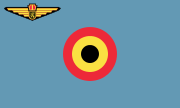 |
The Belgian Air Component (Dutch: Luchtcomponent, French: Composante air) is the air arm of the Belgian Armed Forces. The Belgian Air Force was founded in 1909 and is one of the world's first air forces.
The commander is Major General aviator Frederik Vansina, appointed on 23 July 2009.[1]
History
Foundation and early years
The Belgian Air Force was founded in 1909 as a branch of the Belgian Army, carrying the name Compagnie des Ouvriers et Aérostiers.[2] King Albert's interest in the military use of aircraft was the main impetus for its formation. Coincidentally, in the civil aviation sector, Baron Pierre de Caters earned the first civil pilot's brevet that same year. Caters would promptly establish an aviation school. At approximately the same time, the War Ministry followed the French military's example and had pilots earn a civil pilot's brevet before their military one.[3]
In 1910, three Belgian lieutenants earned their pilot's brevets at the school, paying their own fees. Two of the artillery lieutenants were Baudoin de Montens d'Oosterwyck, who earned Brevet No. 19 on 30 September, and Alfred Sarteel, granted No. 23 on 10 November. The third lieutenant, Georges Nelis, was the new force's first aviation candidate, gaining Brevet No. 28 on 21 December. An aircraft was personally purchased for him.[3]
In spring of 1911, the new air force established its military aviation school with five pilots, two mechanics, and a woodworker. It received its first aircraft via Baron Caters, who gave the aircraft to King Albert, who in turn presented it to the school.[3]
On 12 September 1912, pilot Lieutenant Nelis and observer Sous Lieutenant Stellingwerff were the first Europeans to fire a machine gun from an aircraft; while Nelis brought the aircraft low, Stellingwerff put some bullets through a sheet staked out on the ground. They were disciplined for their efforts. Nelis then accompanied Capitaine Commandant Émile Mathieu to England during November 1913 to demonstrate aerial use of the Lewis machine gun at Hendon and Aldershot; as a result, the British adopted the Lewis, although the Belgians did not. Belgium entered World War I with aircraft tasked solely for reconnaissance missions.[4]
World War I

By the time of Belgium's entry into the First World War on 4 August 1914, the military aviation branch, now called the Aviation Militaire Belge, consisted of four squadrons, each consisting of four 80-horsepower Henri Farman aircraft, although Escadrilles III and IV were still forming. A truck was assigned to each squadron, along with a fifth truck serving as a mobile workshop. Each squadron had a commander, five pilots, and six observers, with all officers seconded from parent units. As a result, most of the new aviators were from the Engineers and Artillery components of the Belgian armed forces. As the war began, a fifth squadron was created, staffed with civilian pilots called to the colors and equipped with Bleriots.[5]
Sous Lieutenant Henri Crombez flew one of the first war patrols, in a Deperdussin racer on 4 August 1914 above Liège.[6] Adjutant Behaeghe was the first to engage an enemy, a few days later. On 26 September, the Belgian air crew of Sous Lieutenant de Petrowski and Sergeant Benselin mortally wounded a German pilot with a rifle bullet and forced his Taube to land at Sint-Agatha-Berchem; if they had submitted a claim for this victory, its approval would have marked history's first air-to-air combat victory.[7]
On 3 January 1915, two machine guns supplied by British were fitted to two Belgian aircraft, making a dual effort against the foe possible; these were Belgium's first dedicated fighter planes. In February, thirteen of the Belgian airmen flew 28 offensive patrols; their first dogfight was fought on the 26th, with ten Albatroses against three Belgian Farmans. On 26 March, Sous Lieutenant Boschmans sent a German two-seater into a steep dive when he seemed to hit the pilot; the German was not seen to either crash or land. This was the Belgian aviators' first victory claim.[8]
In April, Lieutenant Fernand Jacquet mounted a machine gun on his pusher aircraft and sought out the enemy. On the 17th, he scored Belgium's first confirmed aerial victory, sending an Albatros reconnaissance aircraft down in flames over Roeselare. Apparently at about the same time, Adjutant José Orta and Sous Lieutenant Louis de Burlet were the first to attack an enemy observation balloon when they dropped three small bombs on a gasbag over Houthulst. Luckily for them, they missed; success would probably have blown them out of the sky.[8]
On 18 January 1916, the decision was made to form a dedicated fighter squadron. On 22 February 1916, Escadrille I became the 1ère Escadrille de Chasse. It consisted of newly supplied Nieuport 10s and one obsolete Farman two-seater. In August, the new squadron would upgrade to Nieuport 11s, and Escadrille V was turned into the 5ème Escadrille de Chasse. The new unit was the first to mount an offensive formation for the new air force; on 15 February 1917, they flew an offensive patrol of seven. By this time, the AMB had grown to 44 aircraft, including 21 fighters. At this point, individual aircraft bore personal markings affixed by their pilots, but no unit designations.[9]
In the summer of 1917, the AMB was allotted an active role in Allied aviation operations at the beginning of the Third Battle of Ypres. In March 1918, the AMB matured into a Groupe de Chasse. At this time, the role of the Escadrilles de Chasse was finally focused on their operation strictly as fighter units. There was a sorting out of pilots into fighter or reconnaissance roles. Not all fighter pilots went into the new fighter units; as of 1 May, 22 remained with reconnaissance units to fly escort missions. The King insisted that Jacquet be given the command of the Group. The newly organized fighter wing contained the two fighter escadrilles; however, 1ère Escadrille de Chasse became 9ème Escadrille de Chasse, and 5ème Escadrille de Chasse became 10ème Escadrille de Chasse. The 11ème Escadrille de Chasse was founded on 28 May to join them. By the start of the Allies final offensive in September 1918, the AMB was incorporated in the Allied aviation effort, and could send 40-plus aircraft into the air at one time. In its short span of service, the Groupe fought over 700 aerial combats and was credited with 71 confirmed and 50 probable victories.[10]
Aircraft procurement difficulties
In June 1916 the nascent air force had received newer aircraft from the French in both single and double-seat versions of the Nieuport 10. The Belgians would continue to upgrade their aircraft throughout the war, though through their dependence on French manufacturers they became the stepchildren of the Allied effort from 1916 onwards.[11] The introduction dates of various types, compared to the date of their acquisition by the Belgians, tells the tale. The Franco-American Lafayette Escadrille had Nieuport 16s as early as May 1916;[12] the Belgians got them at the end of the year. The Nieuport 17 came into service with the French as early as June 1916, but the Belgians received so few that in June 1917 they were still operating all their earlier Nieuports. They then contracted for newer Nieuport 23s, which were basically up-engined Nieuport 17s. Spad VIIs had entered French service on 2 September 1916; the Belgians first received them almost an entire year later, with the first one on board on 22 August 1917. In September 1917, Belgium had the Hanriot HD.1 supplied to it the year after it was introduced. Spad XIIIs also came on line that month, but would not show up in Belgian inventory until the next year. Sopwith Camels first went into service in May 1917 and the AMB received its first one on 29 November 1917.[13]
The AMB did make one attempt to design and build its own aircraft. However the Ponnier M1 was not good enough for production, and the ten or so manufactured ended up with clipped wings as powered "Penguin" rollers for training rookie pilots.[14]
Operational summary
One of its flying ace pilots, Willy Coppens, became the top ranking balloon buster of World War I, as well as one of the war's top aces. Four other pilots from the tiny force also became aces with it: Andre de Meulemeester,[15] Edmond Thieffry,[16] Jan Olieslagers,[17] and Fernand Jacquet.[18] A sixth Belgian, Adolphe DuBois d'Aische, became the war's oldest ace while in French service.[19]
The fledgling air force was entrusted with flying both King Albert and Queen Elizabeth over the battle front at times.[20]
Between the world wars
During the interwar period, the Belgian Air Force flew the Breguet 19. Some efforts were made to acquire aircraft from local production, such as those by Stampe et Vertongen and Renard. They also evaluated native designs like the ACAZ C.2 and LACAB GR.8, none of which entered mass production however.
World War II

At the start of World War II, the Army Air Force had three active Air Force Regiments. Aircraft which were used by those regiments were the Renard R-31 and R-32, the Fiat CR.42, the Hawker Hurricane, the Gloster Gladiator, the Fairey Fox, and the Fairey Battle. These were massacred by the much superior German Luftwaffe in the German invasion of May 1940.
The following (possibly incomplete) table lists the inventory of the Belgian Air Force as in May 1940.[21]
| Aircraft | Photo | Origin | Type | Year acquired | In service |
|---|---|---|---|---|---|
| Fairey Battle |  | | Light bomber | 1938 | 16 |
| Fairey Fox |  | | Light bomber and observation | 1933–1938 | 154 |
| Fiat CR.42 |  | | Fighter | 1940 | 27 |
| Fokker F.VII |  | | Transport | 1935 | 9 |
| Gloster Gladiator |  | | Fighter | 1937 | 22 |
| Hawker Hurricane |  | | Fighter | 1939 | 20 |
| Koolhoven FK.56 | | Advanced trainer | 1940 | 12 | |
| LACAB GR.8 | | Bomber prototype | 1936 | 1 | |
| Morane-Saulnier MS.230 |  | | Observation | 1932 | 23 |
| Potez 33 | | Light bomber and reconnaissance | 1930 | 10 | |
| Renard R.31 | | Observation | 1935 | 33 | |
| Renard R.38 | | Fighter prototype | 1940 | 1 | |
| Caproni Ca.335/SABCA S.47 / |  | | Light bomber prototype for local production | 1940 | 1 |
| Savoia-Marchetti SM.73 |  | | Transport | 1940 | 8 |
| Savoia-Marchetti SM.83 |  | | Transport | 1940 | 3 |
| Stampe et Vertongen SV.5 Tornado | | Training | 1936 | 21 | |
| Stampe et Vertongen RSV.22 | | Training | 1933 | 10 | |
| Stampe et Vertongen RSV.26 | | Training | 1933 | 10 |
Before the outbreak of the war Belgium also sought to equip the Aviation Militaire with foreign designs, ordering production licences in Poland and France and aircraft in the USA. However, the acquired licences could not be used until May 1940 and the aircraft produced in the USA were eventually delivered to France and to the United Kingdom. The following table summarizes Belgium's foreign orders:
| Aircraft | Photo | Origin | Type | Year acquired | Number |
|---|---|---|---|---|---|
| Breguet 693 | | Light bomber and assault aircraft | 1940 | Licence to build 32 | |
| Brewster B-339 |  | | Fighter | 1939 | 40 ordered, 1 delivered to Bordeaux, 6 to Martinique, rest to RAF[22] |
| Douglas DB-7 | 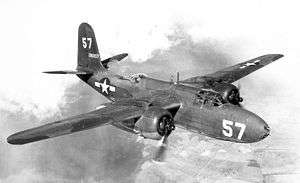 | | Medium bomber | 1939 | 16 ordered, transferred to RAF after surrender |
| PZL.37 Łoś |  | | Medium bomber | 1938 | Licence to build acquired, none built |
| Grumman Martlet |  | | Fighter | 1940 | An order for at least 10 aircraft was placed, but never delivered and they were transferred to Royal Navy after the Belgian surrender, aircraft was proposed with fixed wings for land-based operations |
| Caproni Ca.313 |  | | Light bomber and reconnaissance aircraft (designated Ca.312) | 1940 | 24 ordered, none delivered |
After the surrender of Belgium on 28 May 1940, a very small Belgian Air Force in exile was created in Great Britain as the Belgian section of the Royal Air Force Volunteer Reserve. This small force was active within the British Royal Air Force, and its squadrons were equipped with the Supermarine Spitfire and Hawker Typhoon.
The Cold War
On 15 October 1946, the Belgian military aviation was turned into an autonomous force, independent of the Belgian Army.
From September 1953 to 1960, the Ecole de Pilotage Avancé ("Advanced Pilots' School") operated Harvards from the Kamina military base in the Belgian Congo.[23] Seemingly about 60 Harvards were at the base.
During the Cold War, the Belgian Air Force operated the following aircraft:
| Aircraft | Image | Origin | Description | Variants | Operated | Notes |
|---|---|---|---|---|---|---|
| Aero Commander 560F | Twin-engined light transport | 560F | 1 | 1961 to 1973 as royal transport | ||
| Airspeed Consul | 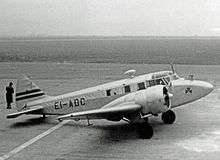 |
Twin-engined light transport | 4 | Used from 1948 in Belgian Congo. | ||
| Airspeed Oxford |  |
Twin-engined light transport | 20 | Operated between 1947 and 1954. | ||
| Auster AOP6 |  |
Single-engine light observation aircraft, | 22 | Operated between 1947 and 1955. | ||
| Avro Anson | %2C_Southend%2C_UK%2C_28_Oct_1965_(8748454616)_(2).jpg) |
Twin-engined light transport | 15 | Operated between 1946 and 1954. | ||
| Avro CF-100 Canuck |  |
Twin-jet interceptor | Mk 5 | 53 | Operated from 1957 into the mid-1960s. | |
| Boeing 727-200 |  |
Three-engined jet airliner | 727-29C | 2 | Operated from 1975. | |
| Dassault Mirage 5 | Jet fighter-bomber (BA), Training (BD) and reconnaissance (BR) | 5BA 5BD 5BR |
63 16 27 |
Operated from 1970 until 1993. 3 were built in France | ||
| Dassault Falcon 20 | _20F-5_(PH-BPS).jpg) |
Twin-engined light jet transport | 20E | 2 | Operated from 1973. | |
| de Havilland Tiger Moth | Biplane trainer | 15 | Operated from 1946. | |||
| de Havilland Dominie |  |
Biplane transport | 7 | Operated from 1946. | ||
| de Havilland Mosquito | _MC-2_Belgian_AF_RWY_01.10.53_edited-3.jpg) |
Twin-engined piston light fighter-bomber | TT3 NF30 |
7 24 |
Operated from 1947 as target tugs and night fighters. | |
| de Havilland Canada Chipmunk | .jpg) |
Single-engined piston trainer | 2 | For evaluation from 1948. | ||
| Dassault/Dornier Alpha Jet |  |
Ground attack | Alpha Jet B | 33 | co designed and build by SABCA | |
| Douglas C-47 Dakota |  |
Passenger/troop transport | 41 | Operated in various roles between 1946 and 1976. | ||
| Douglas DC-4 | 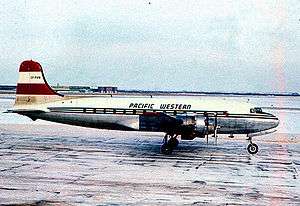 |
Four-engined piston airliner | 2 | Operated from 1950 to 1969. | ||
| Douglas DC-6 | 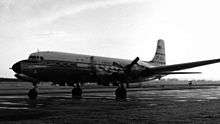 |
Four-engined piston airliner | 4 | Operated from 1954 to 1971. | ||
| Fairchild C-119 Flying Boxcar |  |
Twin-engined troop or cargo transport | C-119F C-119G |
46 | Operated from 1952 to 1973. | |
| Fouga Magister |  |
Jet trainer | CM.170R | 50 | Operated from 1960 to 2007 | |
| SABCA F-16 | %2C_taxiing%2C_Radom_AirShow_2005%2C_Poland.jpg) |
Fighter | F-16A F-16B |
136 24 |
Built under licence in Belgium and the Netherlands. | |
| Gloster Meteor |  |
Jet fighter | F4 T7 F8 NF11 |
48 43 260 24 |
Operated from 1949 some built in Belgium and the Netherlands | |
| Hawker Hurricane |  |
Piston fighter | II | 3 | Operated from 1946 | |
| SABCA Hunter | _kemble_arp.jpg) |
Jet fighter | F4 F6 |
148 144 |
Operated from 1956. Hawker Hunter built in Belgium under licence | |
| Hawker Siddeley 748 |  |
Twin-engined transport | 2A | 3 | Operated from 1976 | |
| Lockheed T-33 |  |
Single engine jet | T-33A RT-33A |
38 1 |
Operated from 1952 | |
| SABCA F-104 Starfighter |  |
Multi-role jet | F-104G TF-104G |
100 12 |
Operated from 1963, Belgian-built. A total of 112 Starfighters were procured by the Belgian Air Force, this being split between 100 F-104G (serial FX-01 to FX-100) and 12 TF-104G trainers (serial FC-01 to FC-12). Of these, 40 F-104G's were MDAP-funded, the remainder being paid for by the Belgian government. With the exception of the very first ones, shipped as CKD kits to Belgium, all Belgian F-104G were built and assembled at SABCA Gosselies plant, alongside 88 other airframes for the Bundesluftwaffe' ("Federal German Air Force") use. The initial three TF-104G were built at Lockheed Palmdale plant, the remaining nine two-seaters being assembled by SABCA from Lockheed CKD kits. The aircraft crashed before being taken on charge by the Belgian Air Force, being later replaced by another similarly numbered machine. This was the aircraft serialled FX-47.[24] | |
| Miles Magister |  |
Single-engines trainer | 1 | Operated from 1946 to 1948 | ||
| Miles Martinet | 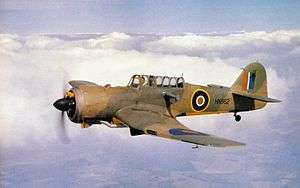 |
Single-engined target tug | 11 | Operated from 1947 to 1953 | ||
| North American T-6 Texan | Basic trainer | Various | 173 | Operated in Belgian Congo | ||
| Percival Proctor |  |
Single-engined liaison | IV | 6 | Operated from 1947 | |
| Percival Pembroke | 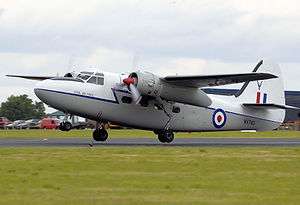 |
Twin-engined light transport | C51 | 12 | Operated from 1954. | |
| Republic F-84 Thunderjet | Single-engined fighter-bomber | F-84E F-84G |
213 | Operated from 1951 | ||
| Republic F-84F Thunderstreak |  |
Single-engined fighter-bomber | F-84F | 197 | Operated from 1955 | |
| Republic RF-84F Thunderflash |  |
Single-engined reconnaissance | RF-84F | 34 | Operated from 1955 | |
| SIAI-Marchetti SF.260 | 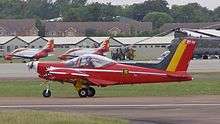 |
Single-engined trainer | SF.260MB | 36 | Operated from 1969 | |
| Stampe SV.4 |  |
Biplane trainer | SV-4B SV-4C |
20 45 |
Operated from 1948 | |
| Supermarine Spitfire | 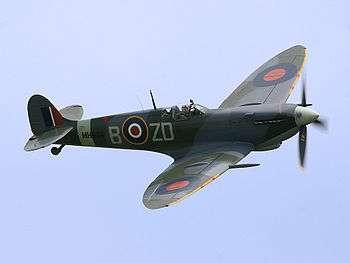 |
Piston-engined fighter | IX, XIV and XVI | 181 | Operated from 1945 | |
| Swearingen Merlin | 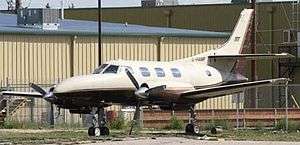 |
Twin-engined light transport | Merlin 3A | 6 | Operated from 1976 | |
| Westland Sea King | Rescue helicopter | Mk 48 | 5 | Operated from 1976, 1 in museum, 1 phased out, 3 to be replaced in 2018 by NH90 | ||
| Aérospatiale SA 316 Alouette III |  | | Light utility helicopter | SA 316B | 3 | Delivered in 1971, used by Belgian Navy, to be replaced by NH90 in 2020. |
Post-Cold War reforms – COMOPSAIR
At the beginning of the 1990s, the end of the Cold War caused the Belgian government to restructure the Belgian Armed Forces in order to cope with the changed threats. The Belgian Air Force was hit hard and saw its strength more than halved with the disbanding of the 3rd Tactical Wing in Bierset (1994); the disbanding of the 1st Fighter Wing in Beauvechain; the 9th Training Wing in Sint-Truiden Air Base; and the Elementary Flying School in Goetsenhoven (1996).
In 2002, the Belgian government decided to emulate Canada and impose a "single structure" on its armed forces in which the independent Belgian Air Force ceased to exist. The Belgian Air Component (COMOPSAIR being the HQ) consists of the 2nd Tactical Wing in Florennes Air Base and the 10th Tactical Wing in Kleine Brogel Air Base, both flying F-16s in four squadrons. Out of the 160 F-16s originally bought by Belgium, only 105 were upgraded; with further reductions to 72 aircraft in 2005; and planned to 60 by 2012. The 1st Wing (Belgium) at Beauvechain Air Base is assigned for the training of pilots, using the piston-powered Aermacchi SF.260 for elementary training, and the Alpha Jet for advanced training. Advanced combat training is done on F-16's at Kleine Brogel.[25]
COMOPSAIR still operates the Lockheed C-130 Hercules in the 15th Air Transport Wing based at Melsbroek Air Base, planning to replace them by seven Airbus A400M transport aircraft. VIPs are transported with Embraer 135/145 jets,[26] Dassault 20/900, and the Airbus A321. The Sea King SAR helicopters and the Alouette III helicopters will be active for years. They will be replaced by NH-90s (4 NFH + 6 TTH).
In 2004, as part of the unified structure, the Army Aviation units of the Wing Heli were transferred to the COMOPSAIR. These contain the Agusta A109 attack helicopter, and the Alouette II training and recce helicopter.
In 2005, the Belgian Alpha Jets moved to Cazaux in France to continue the Initial Operational Training, while the Advanced Jet Training was done on French Alpha Jets at Tours. As from 2013 both Advanced Jet Training as well as Initial Operational Training are completed in Cazaux in France.
Within the framework of its commitments within the North Atlantic Treaty Organization, NATO, Belgium has assigned its 72 F-16s to NATO purposes. Two squadrons with a total of 16 aircraft have been designated for use by the Rapid Reaction Forces.
In February 2008, Defense Minister Pieter De Crem announced that due to increasing problems and poor serviceability, the two A310s were to be replaced as soon as possible by two aircraft in the same class. An Airbus A330 was dry-leased to take their place till March 2014 where it was replaced by an Airbus A321.
On September 1, 2010, the Wing Heli in Bierset was disbanded and the Agusta A109 helicopters moved to Beauvechain Air Base to become 1st Wing. The SF260 squadrons became part of the Basic Flying Training School.
On May 24, 2011, it was reported that the two retired Airbus A310 aircraft have been sold to the Brussels-based company MAD Africa for the amount of 700,000 euros. The company then sold them on to the Dutch Van Vliet transport company, who in their turn will transfer the aircraft to an as yet unspecified Abu Dhabi-based operator.
Recent operations
1990s
In January 1991, 18 Mirage 5 aircraft of the 3rd Tactical Wing were deployed to Turkey's Diyarbakır air base. During this operation, Belgian aircraft carried out several flights along the Iraqi border. After this operation the obsolete Mirage 5s were phased out.
On 15 July 1996, a C-130 with serial CH-06 carrying 37 members of the Dutch Army Fanfare Band and four Belgian crew members crashed at Eindhoven after a bird strike while executing a go-around, resulting in the loss of power to two engines. 34 passengers were killed, and only 7 survived. The accident is known in the Netherlands as the Herculesramp.
From October 1996, the Belgian Air Force cooperated with the Dutch Royal Air Force in the "Deployable Air Task Force" in patrolling former Yugoslavian airspace. F-16s of the 2nd and 10th Tactical Wings, operating from the Italian bases of Villafranca and Amendola, were assigned to missions insuring the control of a No-Fly Zone over Yugoslavia, and providing the air support necessary for UN and NATO troops. Between March 24 and June 10, 1999, twelve Belgian F-16s carried out 679 combat sorties – the first time since the second World War that Belgian aircraft took part in active war operations in enemy territory – against Serbia during the Kosovo crisis. The last Belgian F-16 detachment left Italy in August 2001.
2000s
On 29 March 2004, four F-16s from Kleine Brogel were transferred under NATO's Baltic Air Policing mission to the Šiauliai Air Base in Lithuania for three months, where they were employed in monitoring the Lithuanian, Latvian, and Estonian skies.
In 2005, the Helicopter Wing (WHeli – HeliW) deployed four A-109 (including one Medevac) in Tuzla, Bosnia. In July, four F-16s deployed to Afghanistan to support the NATO International Security Assistance Force.[27] From June to October 2005, the 80th UAV Squadron deployed its B-Hunter in Tuzla.[28][29]
In 2006, Belgian Hunter unmanned air vehicles deployed to the Democratic Republic of the Congo as part of the EU EUFOR peacekeeping mission. At the same time, the Helicopter Wing (WHeli – HeliW) deployed three A-109 (including 1 Medevac) in Mostar, Bosnia, in Operation Blue Bee.[30]
On 1 December 2006 the Belgian Air Component deployed again under Baltic Air Policing mission four F-16 MLU aircraft to Šiauliai Air Base in Lithuania, to defend the airspace of Estonia, Latvia, and Lithuania.[31]
From August 2008, four F-16s were deployed to Kandahar in Afghanistan in support of the Dutch land forces.[32]
In March 2011, Belgium deployed six F-16 fighters to Araxos in Greece, in support of Operation Odyssey Dawn, to support the NATO operations over Libya.[33] The aircraft were already at the base as part of a joint exercise and were transferred to NATO command. Up to June 2011, the aircraft had flown over 1,000 hours over Libya and attacked various military installations and targets.
2010s
On 12 September 2011 a Wikileaks document showed a diplomatic cable from the American ambassador and the Minister of Defence Pieter De Crem that Belgium is interested in buying off-the-shelf Lockheed F-35 Lightnings by 2020.[34][35][36]
In 2013 the Belgian Air Force supported French operations in Mali providing Medevac helicopter support with two A-109 helicopters and two C-130 Hercules in a tactical air transport role.
On 2 September 2013, four F-16 Fighting Falcon fighter-jets of the Royal Belgian Air Force landed at the Šiauliai Air Base to take charge of NATO's Air Policing mission over the Baltic states.[37][38]
Between October 2014 and July 2015 six Lockheed Martin F-16AM Fighting Falcon's were deployed under Operation Desert Falcon to Muwaffaq Salti Air Base as part of military intervention against the Islamic State of Iraq and the Levant.[39]
Joint air policing
On 4 March 2015, the Belgian and Dutch ministers of defence, along with the ambassador of Luxembourg to the Netherlands, signed an agreement on joint air policing. Starting mid-2017, the Belgian Air Component and the Royal Netherlands Air Force will take turns keeping two F-16s on quick reaction alert (QRA) defending the airspace of all three Benelux countries. The agreement could allow the Belgian minister of defence to order a Dutch aircraft to use lethal force over Belgian airspace, and vice-versa. Luxembourg, while currently covered by Belgian QRA, does not allow the use of lethal force over its territory.[40]
Aircraft inventory
| Aircraft | Origin | Type | Service entry | No. used | Notes |
|---|---|---|---|---|---|
| Aermacchi SF.260D & M+ | Italy | trainer | 1969 | 32[41][41] | Based at Beauvechain AB. |
| Agusta A109 | Italy | Light Utility Helicopter | 1992 | 8 | 46 delivered (28 Anti-Tank and 18 LUH), 20 operational (2015)[42] |
| Airbus A321 | EU | transport | 2014 | 1[41] | Leased from Hi Fly with civilian registration CS-TRJ.[43][44] |
| Airbus A400M Atlas | EU | transport | n/a | 0 | 7 ordered, deliveries 2018-2020[45]to replace C-130.[46] |
| SABCA Alpha Jet 1B+ | Belgium | trainer | 1978 | 29[47] | Based at Cazaux AB, France for training with French Air Force. |
| Dassault Falcon 20 | France | VIP transport | 1973 | 1[41] | Out of original 2, 1 already retired in 2015, will be phased out in 2016. |
| Dassault Falcon 900 | France | transport | 1[41] | ||
| Embraer ERJ 135LR | Brazil | transport | 2[41] | ||
| Embraer ERJ 145LR | Brazil | transport | 2[41] | ||
| General Dynamics F-16AM & BM Fighting Falcon | US | fighter | 1979 | 54 | 5 stored. To be replaced by 34 aircraft. |
| IAI MQ-5B Hunter | Israel | Reconnaissance UAV | 2004 | 13[48] | Observation and intelligence gathering.to be replaced by the end of 2018 |
| Lockheed C-130H Hercules | US | transport | 1972 | 11 | 12 delivered, 2 lost, 1 replacement (CH-13). Based at Melsbroek AB.[49] |
| NHI NH90NFH & TTH | EU | Maritime/SAR/ Transport helicopter | 2014 | 4/4 | + 2 options for TTH[50][51][52] |
| Westland Sea King | UK | SAR Helicopter | 1976 | 2 | Out of 5 model Mk48 originally acquired in 1976, 2 operational until 2018 due to delays in NH-90 |
| Aérospatiale SA 316 Alouette III | FR | Light Utility Helicopter | 1971 | 3 | Used by Belgian Navy, operational since 1971, to be replaced by NH-90 in 2020 due to delays |
See also
Notes
- ↑ Schoofs, Jos (July 2009). "A New Commander For The Air Component". Belgian Wings. Retrieved 21 August 2015.
- ↑ Van Humbeek, Frans & Van Caesbroeck, Paul (2015). "Licht Vliegwezenlaan (Brasschaat)". Hangar Flying: Online Database of the Belgian Aviation Heritage (in Dutch). Retrieved 21 August 2015.
- 1 2 3 Pieters (1998), p.9
- ↑ Pieters (1998), p.11
- ↑ Pieters (1998), pp.10–11
- ↑ Deneckere, Bernard (2010). Luchtoorlog boven België 1914 [Air War over Belgium in 1914] (in Dutch). Roeselare: Roularta. ISBN 9789086793013.
- ↑ Pieters (1998), pp.11–13, 21
- 1 2 Pieters (1998), p.12
- ↑ Pieters (1998), p.14
- ↑ Pieters (1998), pp.17-18
- ↑ Pieters (1998), pp.12, 17
- ↑ "Escadrille 124". The Aerodrome. 2015. Retrieved 21 August 2015.
- ↑ Pieters (1998), pp.15–16
- ↑ Pieters (1998), p.16
- ↑ Pieters (1998), pp.46–47
- ↑ Pieters (1998), pp.78–79
- ↑ Pieters (1998), pp.72–73
- ↑ Pieters (1998), pp.62–63
- ↑ "Adolphe Aloys Marie Hubert duBois d'Aische". The Aerodrome. 2015. Retrieved 21 August 2015.
- ↑ Pieters (1998), pp.21–22
- ↑ Leulliot, N. (2001). "Aéronautique Militaire Belge: Order of Battle, 10 May 1940". France 1940. Retrieved 21 August 2015.
- ↑ Pacco (2003), p.71.
- ↑ Pécriaux, V. (2015). "EPA à Kamina". Les Ailes Militaires Belges (in French). Retrieved 21 August 2015.
- ↑ "Belgian Air Force T/F-104G Starfighter". Belgian Wings. Retrieved 21 August 2015.
- ↑ "Belgium Air Component Order of Battle". Scramble.nl. Retrieved 24 December 2014.
- ↑ "Photos: Embraer ERJ-135LR (EMB-135LR) Aircraft Pictures". Airliners.net. Retrieved 24 December 2014.
- ↑ "NATO Update: Alliance augments air power in Afghanistan". NATO. 12 July 2005. Retrieved 21 August 2015.
- ↑ "80 Unmanned Aerial Vehicle Squadron". Belgium Defence (in French). 2015. Retrieved 21 August 2015.
- ↑ "Eagle B-Hunter UAV (Unmanned Aerial Vehicle)". Belgian Military Aircraft Database. 2015. Retrieved 21 August 2015.
- ↑ "BAHA News 2006: Belgian Defence Agusta helicopters deployed to Mostar in Bosnia-Herzegovina". Belgian Wings. June 2006. Retrieved 21 August 2015.
- ↑ "Belgium F-16s to police Baltic airspace". f-16.net. Retrieved 24 December 2014.
- ↑ "Belgium to deploy 4 F-16s to Afghanistan". f-16.net. Retrieved 24 December 2014.
- ↑ "Belgium sends four F-16s to Libya". Belgian Federal Government. 22 March 2011. Retrieved 21 August 2015.
- ↑ Shalal-Esa, Andrea (17 September 2013). "Belgium considers Lockheed F-35 to replace F-16s". Reuters. Retrieved 24 December 2014.
- ↑ Hoyle, Craig (16 November 2013). "Belgium to launch F-16 replacement process". Flightglobal. Retrieved 21 August 2015.
- ↑ Deutsch, Anthony; Shalal-Esa, Andrea (17 September 2013). "Dutch government says to purchase 37 F-35 fighter planes". Reuters. Retrieved 21 August 2015.
- ↑ "Belgian fighter-jets landed in Šiauliai to take over of the Baltic Air Policing mission". The Lithuania Tribune. 4 September 2013. Retrieved 24 December 2014.
- ↑ Cenciotti, David (22 September 2014). "The most interesting aircraft displayed at the Belgian Air Force Days". The Aviationist. Retrieved 24 December 2014.
- ↑ AirForces Monthly. Stamford, Lincolnshire, England: Key Publishing Ltd. September 2015. p. 74.
- ↑ Fiorenza, Nicholas (11 March 2015). "Benelux countries agree to joint air policing". Jane's Defence Weekly 52 (10): 13. Retrieved 10 July 2015.
- 1 2 3 4 5 6 7 "Belgian Defense Information". European Defense Information. Armed Forces.co.uk. Retrieved 22 April 2014.
- ↑ http://helispot.be/hs/helicopters/model.asp?id=d4E3f7
- ↑ Martin, Andy. "Airbus A321-231". Air Team Images. Retrieved 22 April 2014.
- ↑ "Belgian air force introduces A321 transport". Flightglobal. 27 May 2014. Retrieved 24 December 2014.
- ↑ "OrBat Belgium". MilAvia Press.com: Military Aviation Publications. Retrieved 24 December 2014.
- ↑ "Airbus A400M Atlas". Belgium Defence (in Dutch). Retrieved 24 December 2014.
- ↑ "Dassault Alpha-Jet". Belgium Defence (in Dutch). 2015. Retrieved 21 August 2015.
- ↑ "B-HUNTER UAV". Belgium Defence (in Dutch). Retrieved 24 December 2014.
- ↑ "Lockheed C-130 Hercules". Belgium Defence (in Dutch). Retrieved 24 December 2014.
- ↑ "NH90 in Force Aérienne Belge". Helis.com. Retrieved 24 December 2014.
- ↑ Hoyle, Craig (9 April 2013). "PICTURE: Belgian maritime NH90 makes first flight". Flightglobal. Retrieved 24 December 2014.
- ↑ Perry, Dominic (25 June 2014). "NH Industries marks delivery of 200th NH90 helicopter". Flightglobal. Retrieved 24 December 2014.
Bibliography
- Pacco, John (2003). Belgisch Leger/Armee Belge: Het Militair Vliegwezen/l'Aeronautique Militaire 1930–1940. Belgium: Aartselaar. ISBN 90-801136-6-2.
- Pieters, Walter M. (1998). Above Flanders' Fields: A Complete Record of the Belgian Fighter Pilots and Their Units During the Great War, 1914–1918. Grub Street. ISBN 978-1-898697-83-1.
External links
| Wikimedia Commons has media related to Air force of Belgium. |
| ||||||

